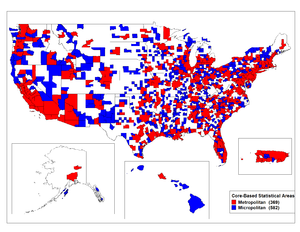
Core based statistical area
Encyclopedia

United States
The United States of America is a federal constitutional republic comprising fifty states and a federal district...
geographic area defined by the Office of Management and Budget (OMB) based around an urban center of at least 10,000 people and adjacent areas that are socioeconomically tied to the urban center by commuting
Commuting
Commuting is regular travel between one's place of residence and place of work or full time study. It sometimes refers to any regular or often repeated traveling between locations when not work related.- History :...
. Areas defined on the basis of these standards applied to Census 2000 data were announced by OMB in June 2003. These standards are used to replace the definitions of metropolitan area
Metropolitan area
The term metropolitan area refers to a region consisting of a densely populated urban core and its less-populated surrounding territories, sharing industry, infrastructure, and housing. A metropolitan area usually encompasses multiple jurisdictions and municipalities: neighborhoods, townships,...
s that were defined in 1990. The OMB expects to define new CBSAs based on the 2010 census in 2013.
The term "CBSA" refers collectively to both metropolitan statistical areas and micropolitan areas
United States micropolitan area
United States Micropolitan Statistical Areas , as defined by the United States Office of Management and Budget, are urban areas in the United States based around a core city or town with a population of 10,000 to 49,999. The micropolitan area designation was created in 2003...
. Micropolitan areas are based around Census Bureau-defined urban clusters of at least 10,000 and fewer than 50,000 people. The map on the right shows the metropolitan areas (in red) and micropolitan areas (in blue) for the CBSAs for the United States and Puerto Rico
Puerto Rico
Puerto Rico , officially the Commonwealth of Puerto Rico , is an unincorporated territory of the United States, located in the northeastern Caribbean, east of the Dominican Republic and west of both the United States Virgin Islands and the British Virgin Islands.Puerto Rico comprises an...
.
The basic definition of metropolitan areas has had slight changes made to it as well. A metropolitan area, as it did in 1990, requires a Census Bureau-defined urbanized area of at least 50,000 people. A metropolitan statistical area containing an urbanized area of at least 2.5 million people can be subdivided into two or more "metropolitan divisions," provided specified criteria are met. Metropolitan divisions are conceptually similar to the primary metropolitan statistical areas (PMSAs) defined under previous standards.


New England
New England is a region in the northeastern corner of the United States consisting of the six states of Maine, New Hampshire, Vermont, Massachusetts, Rhode Island, and Connecticut...
regions as county-based areas. In the past, these were referred to by the Census as "NECMA"'s (New England County Metropolitan Areas) and were separate from the normal census counts for the areas, which used cities and towns as their basis. They have essentially swapped places now, with the city and town areas (or NECTAs for New England City and Town Area
New England City and Town Area
A New England City and Town Area or NECTA is a geographic and statistical entity defined by the U.S. Office of Management and Budget, for use in describing aspects of the New England region of the United States...
s) being the separate listings.
Despite there not being much change in the basic definition, 49 new metropolitan areas were formed as a result of the new rules for them. Over 550 other areas were classified as micropolitan. All told, the present rules have defined 935 CBSAs in the U.S. and Puerto Rico. 11 of the CBSAs have metropolitan divisions, 29 in total. In comparison, the definition of metropolitan areas in 1999, the last year areas were formed based on the 1990 rules for them, there were 284 metropolitan areas, with 19 of the areas providing 76 primary metropolitan areas (the equivalent of divisions); almost three times the number of areas overall are now recognized by the OMB.
See also
- Demographics of the United StatesDemographics of the United StatesAs of today's date, the United States has a total resident population of , making it the third most populous country in the world. It is a very urbanized population, with 82% residing in cities and suburbs as of 2008 . This leaves vast expanses of the country nearly uninhabited...
- Table of United States Combined Statistical AreasTable of United States Combined Statistical Areasthumb|An enlargeable map of the 125 [[Combined Statistical Area]]s of the [[United States]]The United States Office of Management and Budget has defined 125 Combined Statistical Areas for the United States of America...
(CSA) - Table of United States Core Based Statistical Areas (CBSA)
- Table of United States Metropolitan Statistical AreasTable of United States Metropolitan Statistical Areasthumb|An enlargeable map of the 942 [[Core Based Statistical Area]]s of the [[United States]]. The 367 [[Metropolitan Statistical Area]]s are shown in red....
(MSA) - Table of United States Micropolitan Statistical AreasTable of United States Micropolitan Statistical Areasthumb|An enlargeable map of the 942 [[Core Based Statistical Area]]s of the [[United States]]. The 576 [[Micropolitan Statistical Area]]s are shown in blue....
(µSA) - Table of United States primary census statistical areas (PCSA)
- List of United States urban areas

